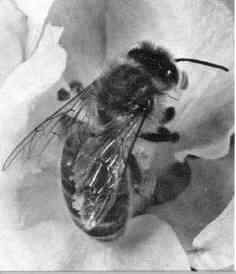 |
Pollination for the Home Gardener
by Howard Veatch*
(Published by Dadant and Sons, Inc. Hamilton, IL 62341 -- Permission to reproduce
granted by Nick Dadant. For the full booklet, contact Dadant & Sons at the above
address. Text scanned and read with Calera Word Scan OCR. Original illustrations can seen
by clicking on the links provided. Slightly edited by David L. Green. |
The home gardener faces an almost bewildering array of problems: the cost
of land has reduced the amount of space available for gardening to a minimum; new
varieties of plants, often hybridized for maximum production, are expensive and require a
substantial amount of knowledge for successful cultivation; and the often indiscriminate
use of insecticides and herbicides has curbed the population of beneficial insects,
seemingly without making great headway with the horde of pests that return to haunt the
gardener yearly.
Gardens still flourish in every nook and cranny of the land because of the
quality and taste available in home-grown fruits and vegetables, but the economics of
gardening are here to stay. It is safe to assume that for the home gardener, the labor
factor is one of love, given freely in exchange for the flavor of home-grown fruits and
vegetables that have no rival in any commercially-grown product. Through the use of
mulches and irrigation, possible with a small plot of ground, even the weather can be
controlled to an extent. Other factors of gardening can he controlled as well. The loss or
non-production of one plant grown in soil of today's prices is an expense that no gardener
can afford. This booklet attempts to reduce one of the risk factors of gardening,
pollination, to an understandable and therefore, manageable, element of cultivation.
THE FLOWER
A flowering plant grows and if the conditions are favorable, produces a
bud, which, in its turn, becomes a flower. The flower fades and fruit develops. One of
Nature's most fascinating and vital cycles, fertilization resulting in reproduction, has
run its course.
Successful cultivation of plants, especially those grown in a confined
area such as the home orchard or garden depends upon the development of large numbers of
well-shaped fruits. The development of this fruit depends upon pollination and pollination
depends upon the flower.
In the plant world there are three basic types of flowers. Male flowers
have only male parts and produce pollen. Female flowers have only female parts and produce
fruit (See Figs. 1 and 2). Perfect or complete flowers have both male and female parts and
produce both pollen and fruit. In order for the fruit to develop, the pollen produced by
the male flower part must be transferred to the female flower part. This transfer is
called pollination.
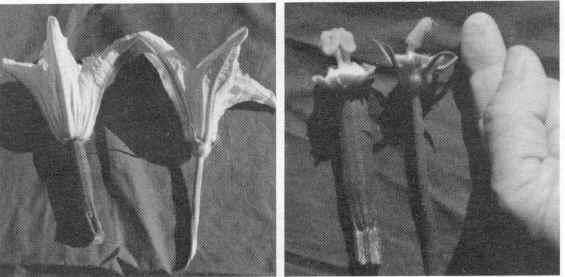
|
Figures 1 & 2
(Left) Blossoms of zucchini squash. The female blossom on the left already
contains the form of the squash that will develop if properly pollinated.
(Right) The petals have been removed to show the difference in the flowers. Note
the pollen-filled anther of the male blossom on the right |
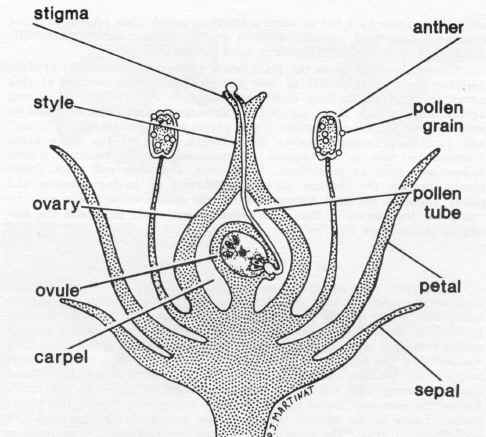
Figure 3: Cross section of a flower
|
Figure 3 shows a cross-section of a complete flower to illustrate this
process. The sepal is one of the scales that forms the calyx, the outside
covering of the bud. Inside the calyx are the petals, variously formed and colored,
which have two functions - protect the inner parts of the flower from damage until
pollination can take place and attract bees or other pollinating agents to the inner parts
of the flower. Next come the stamens or the male parts of the flower and on top of
each stamen is a sac-like anther which produces the pollen grains. When the pollen
grains are mature, the anther opens and the pollen is discharged. The pollen is
transferred from the anther to the stigma, the sticky end of the pistil, or
innermost part of the flower. |
When a pollen grain reaches the stigma, it germinates, growing down to the
ovary where it unites with an ovule which then develops into a seed. When every seed
natural to the fruit is fertilized, the fruit develops perfectly. The less complete
blossom fertilization, the less perfect the fruit.
Figure 4
Lopsided apple resulting from incomplete seed formation due to inadequate pollination |
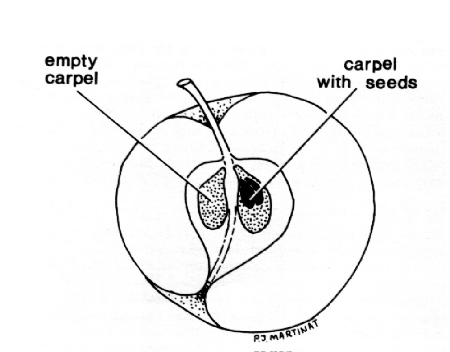 |
If the pollen transfers from the anther to the stigma of
the same flower or to flowers of the same plant or other plants of identical genetic
material, it is called self-pollination. (Editor's note: it would be more accurate
here to use the term self-fertilization. The term self-pollination is oxymoronic
when used with flowers that need help from a pollinator.)
The pollen of many farm crops such as grains is light and dry and is
carried long distances from anther to stigma by wind-pollination. The pollen of
other plants such as legumes, fruits, and many vegetables is moist and sticky and too
heavy for air currents and must be transferred from anther to stigma by a bee or other
pollinating agent. This process is called cross-pollination and provides a much
greater genetic variety than self-pollination or the often haphazard wind-pollination.
Cross-pollination gives the plant much greater opportunity to produce
mutations and adapt itself to new environments. It is because of this advantage that
plants have developed flowers to attract cross-pollinating agents such as bees. Some
plants have developed mechanisms to lessen or entirely prohibit self-pollination. These
plants may have staminate "male" and pistillate "female" flowers on
different parts of the same plant (monoecious), as in the squash or cucumber, or on
separate plants (dioecious), such as persimmon, holly trees, and some nut trees. Other
plants increase the chances of cross-pollination by having stamens and pistils ripen at
different times; that is, the pollen of a flower may be ready but the stigma of that same
flower is not ready to receive the pollen, or the reverse may be true.
BEES AS POLLINATING AGENTS
Cross-pollination is carried on mainly by insects, especially by honey
bees, bumblebees, and to a very limited extent, other bee-like insects. The honey bee, of
all insects, is most peculiarly adapted to the task of cross- pollination. Most insects
lie dormant during the winter period and in spring come out only in small numbers, until
increasing generations have reestablished the dominance of the species. The honey bee,
however, lives over in large numbers among the combs of the beehive where they cluster
together during cold weather, consuming the honey stored in the combs during the previous
season to furnish heat and energy during the winter period. Early in the spring, the queen
bee begins to lay eggs and new bees begin to grow. The urge for food has assumed sizeable
proportions when fruit bloom arrives.
Bees gather nectar and pollen from flowers for food for their own use and
cross-pollination is entirely incidental to this search for food. Of all the insects
visiting flowers, the honey bee is the best adapted to act as a carrier of pollen. The
body and legs are covered with heavy, branched hairs which catch and hold the pollen
grains. The hind legs of the honey bee contain pollen baskets, somewhat concave
spaces fringed with long curved hairs. The bee collects pollen, which will be a major food
source for the emerging young bees in the hive, and packs it into the pollen baskets as
shown in Fig. 5, Fig 6, Fig 7, and Fig 8.
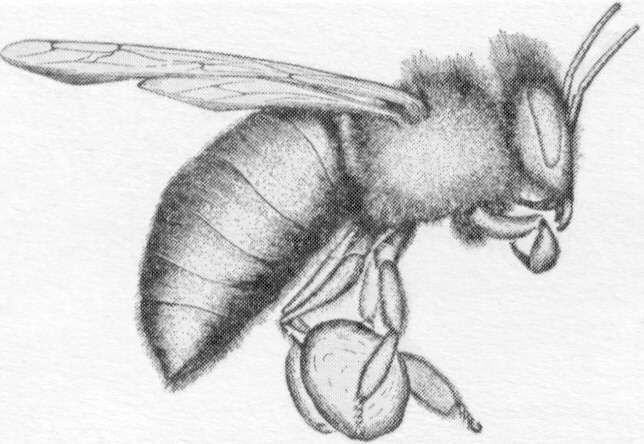
|
Figure 5. Bee, showing pollen basket |
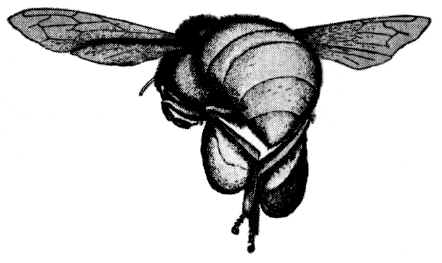
|
Figure 6. The pollen grains are packed tightly with
the feet. |
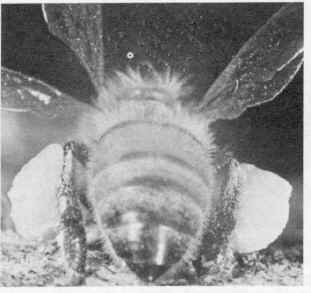
|
Figure 7. Pollen laden bees are common in the spring |
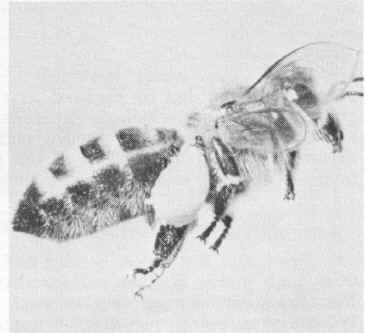
|
Figure 8. You can learn to identify pollen sources |
During this process the moist and sticky pollen grains
become lodged in the body hairs of the bee and may fairly cover her as she flies to
another flower of the same species (See Fig. 9).
| Figure 9, The pollen lodged in the body hairs will be transferred to
other flowers. |
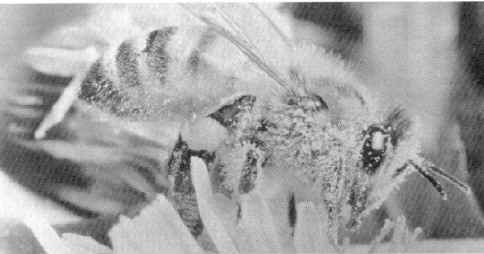 |
If the bee should brush against the stigma of the next flower visited and
brush off some of the pollen grains held in her body hairs, the act of cross-pollination
will be completed (See Fig. 10)

| Figure 10, A honey bee seeks nectar from the
base of flowers whose ripened anthers dust the bee with pollen. Pollen
is carried among the hairs on the body of the honey bee to another flower of the same
species.
Here the bee may brush against the stigma leaving some pollen, completing the
act of cross-pollination.
Diagram by Charles W. Gouget |
Bees also have a habit which is of utmost value from the standpoint of
cross-pollination. They are flower-constant, that is, when working on blossoms for either
nectar or pollen, bees seldom visit more than one kind of flower at a time. In other
words, a bee that has started to gather nectar from apple blossoms will continue to gather
nectar from apple blossoms until that period of foraging has ended. This constancy is of
great importance as it ensures cross-pollination only within the kind of fruit being
visited.
Finally, the honey bee is the only insect which can be distributed through
the garden or orchard at the will of the owner. It is the only pollinating agent which is
practically under his control. With proper attention to orchard and garden planting, to
provide pollinating varieties discussed further on, the use of the honey bee will help
ensure a satisfactory set of fruit and seed under most circumstances.
THE VALUE OF THE HONEY BEE AS A POLLINATING AGENT
Fruit and nut trees, berries and vegetables often fail to bear or produce
high yields because self-sterility is very common. Self-sterile means that the
plant cannot develop seed when pollinated with its own pollen. It occurs in many varieties
of apples, most varieties of pears, probably in all sweet cherries, in most varieties of
native and Japanese plums, and in some varieties of European and domestic plums and
prunes. Even fruits which are considered to be self-fertile, that is, capable of setting
seed with pollen of their own kind, will, to a high degree, set a better crop of fruit if
cross-pollination occurs.
Many experiments have been conducted in attempts to set a value on the
pollinating services provided by bees. Most of these experiments have produced dramatic
results.
In the W. R. Roach Company orchards of Michigan, a McIntosh apple tree was
screened to keep bees away from it. Throughout the rest of the orchard, bees had
previously been placed in groups. The screened tree set twenty-five apples while its
nearest neighbor forty feet away, where provision had been made for cross-pollination, set
over 1200 apples.
In another experiment in the same orchard, one cherry tree was caged to
prevent the bees from reaching it. The harvest was four pounds of cherries. Another tree
the same size, exposed to bees, gave a harvest of forty-four pounds of cherries. Forty
pounds of cherries is impressive evidence of the value of bees as pollinators.
While some crops are dramatically increased both in quantity and quality
through the use of bees as pollinators, for other crops, bees make the difference between
having a crop and no production at all! Caging experiments with cantaloupes and cucumbers
have shown that bees must have access to the plants to transfer the pollen - no honey
bees, no cantaloupes or cucumbers!

Figure 11 This picture tells a pollination story that every
gardener should be aware of. The light-colored, undeveloped fruit at the right was a
female blossom that opened when there were no male blossoms open. The blossom was not
pollinated and the fruit failed to develop. The developing fruit on the left was a female
blossom that opened when male blossoms were also open and there were bees to complete the
cross-pollination. Result: one fine Zucchini squash in the making.
There are almost five million colonies of honey bees (Ed note: less
than three million today) in the U.S. and each of these colonies may contain up to
80,000 bees, all from the same queen. These honey bees produce about 200 million pounds of
honey every year but for every dollar the beekeeper realizes from his bees, the public
benefits by $100 from their pollination activities. Honey and beeswax production is a
small item when compared to the total value of all agriculture. But when the value of bee
pollination, crops aided by bee pollination, and crops dependent upon bees for seed are
all added up, the value is equal to about one-third of all the U.S. agricultural
production.
Studies indicate that about 90 crops in the U.S. depend upon bees at least
to some extent for pollination, and bees, overall, are credited with over one-third of the
food we eat because of their pollination of farm crops. Bees also contribute to the
overall environmental balance by pollinating many seeds, berries, and fruits used in food
chains of wildlife.
WILD BEES AS POLLINATORS
In an earlier day there were enough wild bees to successfully pollinate
field and garden crops but this is not the case today. As agriculture developed and more
land came under cultivation, the nests of the wild pollinating insects were destroyed.
Heavy grazing of land took a further toll, as did the elimination of rail fences and
hedges. Planting of large areas to a single crop, forest and grass fires, and the
automobile and paved roads added to their destruction. Housing developments and entire
suburbs mushroomed out from cities and brought once natural habitats of pollinating
insects under immense changes. The final step was the widespread use of insecticides,
which destroyed beneficial insects as well as those which were harmful, and the use of
herbicides, which not only was harmful to wild pollinating insects, but destroyed their
sources of food and habitats. Practically every agricultural practice, whether in a farm
field or on a city lot has contributed to the destruction of wild pollinating insects.
With the decline of the wild insects, more and more of the pollination
task fell to the honey bee, the only insect which man can move from place to place and
control for this purpose. Today it is estimated that more than 80 per cent of all
pollination required for set of fruit and seed crops is accomplished by honey bees.
VINE CROPS
Vine crops (squash, cucumber, cantaloupes, watermelon, pumpkin) have all
three flower types. Most cantaloupes and related melons produce staminate (male) flowers
as well as hermaphroditic (perfect) flowers, while most cucumbers and watermelons have
both staminate and pistilate flowers. They all have many seeds and each seed was formed by
the union of the contents of a single pollen grain and a single ovule. Inadequate
pollination will result in underdeveloped and misshapen fruits. In the case of cucumbers
and other plants where the sexes are produced in separate flowers, there will be no fruit
set at all unless bees are present to perform cross-pollination.
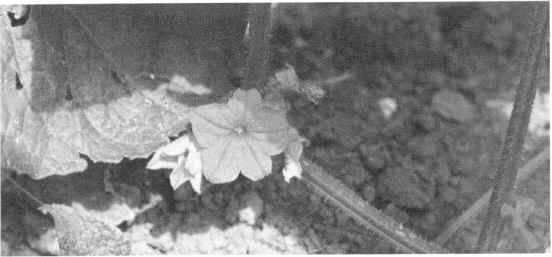
Figure 12, In this closeup of a cucumber vine in bloom,
the female fruit-producing blossom is open and ripe for pollination but the surrounding
male blossoms have already closed. Fruit will not develop here unless other male blossoms
are open, elsewhere on the same vine or nearby on other vines and there are adequate
numbers of honey bees to transfer the pollen from the male to the female blossoms.
As illustrated by the cucumber shown in Fig. 12, most of the vine crop
flowers are only open for brief periods of time. Male flowers usually appear first,
followed by the fruit-producing flowers. The timing of the act of pollination is crucial.
Remember also, as in the case of melons, that the fruit produced nearest the crown of the
plant is often sweeter, larger, and better-shaped than those produced elsewhere on the
same vine. To obtain the choicest fruit, which after all is one of the goals of the home
gardener, it is necessary to provide adequate numbers of honey bees to transfer the pollen
as soon as the fruit-producing flowers appear.
SMALL FRUIT POLLINATION
Most of the berries such as the ones listed below depend upon bee
pollinators to produce high yields and well-developed, full-fleshed berries that are the
pride and joy of the home gardener:
red raspberry
thimbleberry
cloudberry
boysenberry
gooseberry
cranberry
red currant
black raspberry |
dewberry
loganberry
elderberry
blueberry
huckleberry
black currant
strawberry |
Berry flowers have many pistils and each must receive its grain of pollen before it can
contribute to the size, shape,and taste of the fruit to come. The degree of response to
insect pollination differs with variety. The drawings below from the Washington State
University will help illustrate this point.

Figure 13, Normal and poorly pollinated raspberry.
Poorly pollinated raspberry may average 8-23 drupelets, compared to 45-90 in
well-pollinated fruits. Normal and poorly pollinated blueberry cross-section. The central
fleshy portion does not develop in poorly pollinated berries.
A poorly pollinated berry crop is not worth the garden space. The flavor
of the home-grown berry lies in the fleshy portion between the seeds or the drupelets as
in the raspberry and if it is poorly pollinated, the berry will likely be small and
misshapen, especially in areas where seeds are entirely missing. Blueberry flowers must be
pollinated by bees or there is no fruit at all. The central fleshy portion between the
seeds in blueberries does not develop in poorly pollinated areas.
The most predominant of the home gardener's berry crop, strawberries and
raspberries, will set some small and misshapen fruit in the absence of insect pollination.
In some areas the native bee population will be sufficient to take care of strawberry and
raspberry crops in the home garden but the gardener should watch his garden closely during
the bloom period to make certain that honey bees are present (See Fig. 14 and 15,
comparing poor strawberry pollination, and good pollination).Cross-pollination
of berry crops are often helped with inter-plantings of two or more varieties and catalog
descriptions should be carefully noted for pollination notices and requirements.
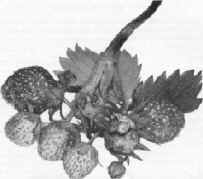
|
Figure 14, The absence of cross-pollination by honey
bees has taken its toll on this strawberry crop. These berries would be a diaspointment
for any home gardener. (Photo, courtesy of Larry Connor, formerly Extension Entomologist,
Ohio State University.) |
| Figure 15, This strawberry plant has received good pollination.The
berries are nicely proportioned, and well developed, indicating that each pistilof the
flower received its grain of pollen necessary to develop properly. (Photo, courtesy of
Larry Connor, formerly Extension Entomologist, Ohio State University.) |
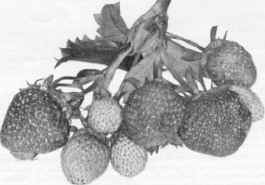
|
FRUIT CROPS
Many varieties of apples, most varieties of pears, probably all sweet cherries, most
varieties of native and Japanese plums, and some varieties of European and domestic plums
and prunes are self-sterile. Most of the self-sterile varieties of fruit trees will carry
a pollination notice in the catalog description or the nursery salesman will point out
requirements as part of his presentation. The following garden fruits and nuts are either
partially or wholly dependent upon bees as pollinating agents:
apple
orange
lemons
tart
cherry
almonds
chestnuts
persimmon |
tangelo
sweet cherry
mango
butternuts
plum
grapefruit
avocado
nectarine |
tangerine
prune
limes
apricot
peaches
crabapple
pear |
The home gardener must plan very carefully before planting even the
smallest orchard. If the total number of trees is limited and if two varieties of some
fruits must be planted for adequate cross-pollination, careful planning is essential. In
addition to knowing the pollination requirements of the intended varieties, the gardener
should know something about bee behavior and the principles of pollination. Bees normally
work a restricted area thoroughly rather than move great distances from tree to tree. For
the gardener with a limited space this means that the trees should be clustered in one
area rather than scattered over the lot. Ideally, every tree of a variety that requires
cross-pollination would have a tree of the pollenizing variety next to it. With the advent
of dwarf fruit trees the problem is not as severe as it once was as several dwarf trees
may be grown in the space formerly required by two or three full-sized trees.
Honey bees fly freely only in warm, sunny weather. In early spring the
pollination of many orchard fruits may be greatly limited by unfavorable weather. There
may be only a few hours of weather suitable for insect visitations. As wild insect
populations are very low at this time of year, it is wise to have an excess number of
honey bees available to ensure adequate pollination.
Apple. Many varieties of apples are self-sterile and require another variety to
obtain adequate pollination so two trees will have to be planned for instead of one. For
the amount of space available in most home gardens, this means very careful planning. Most
of the early and late blooming varieties overlap sufficiently in their bloom periods to
permit satisfactory pollination of one variety by another but if choosing a variety
specifically for its value as a pollinator, be sure to choose one blooming close to the
principal variety. Apple blossoms produce more nectar than most fruits and are quite
attractive to honey bees in or near the orchard. One colony per acre of mature orchard is
considered a minimum.
Cherry. Tart cherries are self-fruitful but the presence of honey bees during
bloom will greatly increase pollination and yield. Sweet cherries are self-sterile and
must have interplantings of a pollenizing variety and honey bees to pollinate the
blossoms. Descriptions in catalogs and nursery representatives are sources for compatible
varieties.
Pear. Nearly all varieties of pears are self-sterile and mixed plantings are
necessary for pollination and yield. With few exceptions, any one variety is suitable for
pollenizing any other variety but a careful check of catalog descriptions for compatible
varieties is always wise. Pear blossoms are not as attractive to bees as other fruit
blossoms and pears will require more bees per acre to achieve the same pollination and
yield as obtainable from other fruits.
Peach. Most varieties of peaches are self-fruitful although the presence of
honey bees will increase the pollination and yield. Bees readily work peach blossoms and
the only factor the home gardener has to watch closely is to be sure that varieties chosen
are self-fruitful and if not, that compatible varieties are planted.
Plum. Most varieties of plums are self-sterile and will require a compatible
companion planting. The period of bloom seems to vary widely and companion plantings must
have a period of overlapping bloom to achieve pollination.
Taking the pollination requirements carefully into consideration and by
choosing carefully among the many varieties offered, the home gardener might well build up
a valuable home orchard. By choosing dwarf or semi-dwarf varieties, an orchard of perhaps
two pear trees, one tart cherry tree, two apple trees, and two plum trees could be placed
well within the confines of the average lot. By working fruit trees carefully into other
plantings, the number might be increased to provide a wide variety of home-grown fruit.
One note of precaution. Do not use poisonous spray materials while the
blossoms are open and bees are present. Honey bees may be protected by completely dropping
poisons from any spraying schedule until after the blooming period. When pollination is in
progress, spraying materially affects the germination of the pollen grains by preventing
them from obtaining a satisfactory growth. This is not to say that sprays should not be
used by the home gardener; rather that they should not be used during the time of active
pollination by honey bees, and that they should be used carefully and only after thorough
understanding of the directions for application and the effects to be expected from any
particular pesticide.
OBTAINING BEES FOR POLLINATION
The commercial fruit-grower has less of a problem than does the home
gardener in obtaining adequate numbers of honey bees to ensure good pollination of his
fruit trees resulting in maximum yields. The commercial fruit grower contracts for
pollination with a beekeeper at a set price per hive of bees and it is then up to the
beekeeper to supply the colonies of bees in peak condition at precisely the right moment
of bloom, set the colonies in the orchard and then remove them when the pollination
service is finished. The home gardener is not likely to have such a service at his
disposal and the expense involved for such a small number of trees would be prohibitive
anyway.
The home gardener is then left with two choices - he can garden on the
hit-or-miss basis and hope that there are enough wild bees in his area to achieve adequate
pollination and enough of a yield to make his plantings worthwhile - or he can take
positive steps to make his efforts pay off and that is what this booklet is all about.
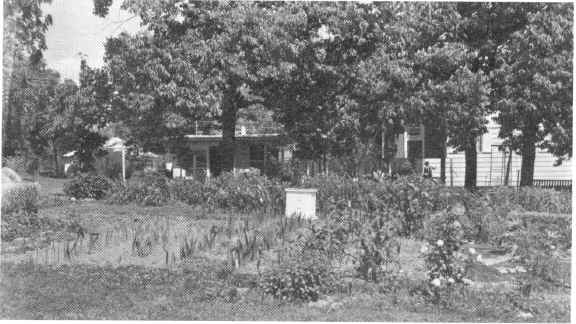
Figure 16, A small colongy of honey bees has found a congeneal home on one
end of a suburban garden. They provide adequate pollination for the fruit trees and garden
crops and an abundant supply of fresh honey.
A small colony of honey bees can nestle very comfortably into one end of a
garden setting as shown above in Figure 16. I n addition to
having a dependable ready source of honey bees for pollination purposes, the gardener has
the bonus of fresh honey collected from his own sources, and the fascination of a new
hobby that pays for itself.
Hives like the one shown above are available in do-it-yourself hobby kits
and hybrid honey bees are available in packages, grown in the South and shipped to all
areas of the country to arrive in time for early fruit bloom (apricot and pear and ending
with apple bloom some four to five weeks later). Usually each package contains two pounds
of bees and inside the package a young queen bee is confined to a separate small queen
cage suspended by a wire, and a small can of sugar syrup is included to feed the bees en
route. Complete instructions for installing the hive and the bees, and handling the bees
are available from the Hamilton address or any one of the branch addresses on the back
cover.
In summary, bees are an essential link in one of Nature's most
fascinating and vital cycles, fertilization resulting in reproduction, resulting directly
or indirectly in the production of food upon which we depend for our very existence. Years
of study and research have brought us to an understanding of this vital cycle and to an
understanding of our dependence upon the honey bee for its pollination services. Recent
years of study and research have brought us the hybrid honey bee, especially bred for
gentleness and added capacities for production. We must still, however, provide the vital
connection in Nature's cycle of reproduction, and that is, provide the bees in sufficient
quantities in the areas in which we want them to work for us.
*Howard Veatch, Director, Dadant Publications, A Division of Dadant
& Sons, Inc., Hamilton, IL 62341. Other Dadant Publications: The American Bee Journal,
First Lessons in Beekeeping, American Honey Plants, and The Hive and the Honey Bee. The
use of information from many sources is herewith acknowledged. Printed in the U.S.A. for
Dadant & Sons, Inc., Hamilton, Illinois.
Back to Home
(Beeswax candles, beekeeping supplies and equipment, beekeeping books, and The
American Bee Journal are available through Dadant &
Sons, Inc.)















